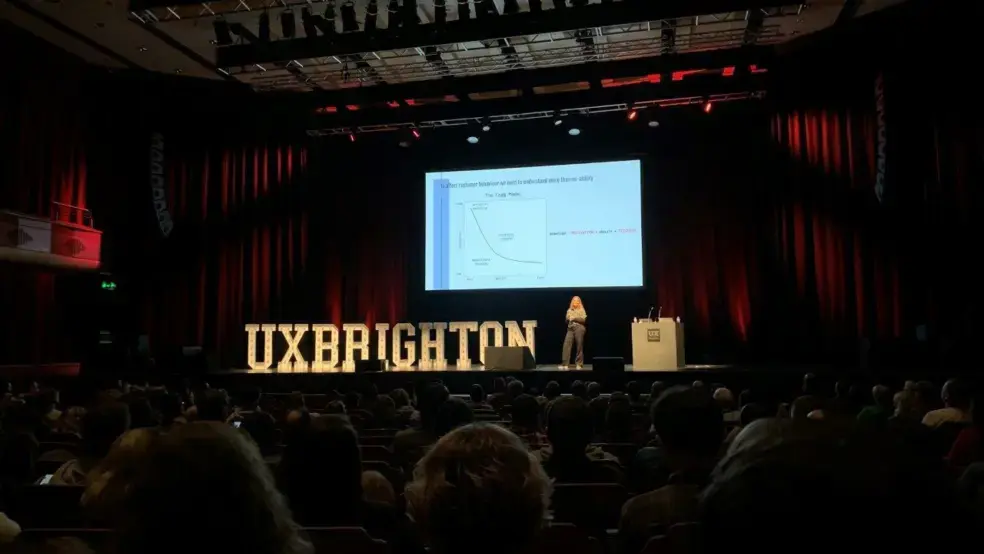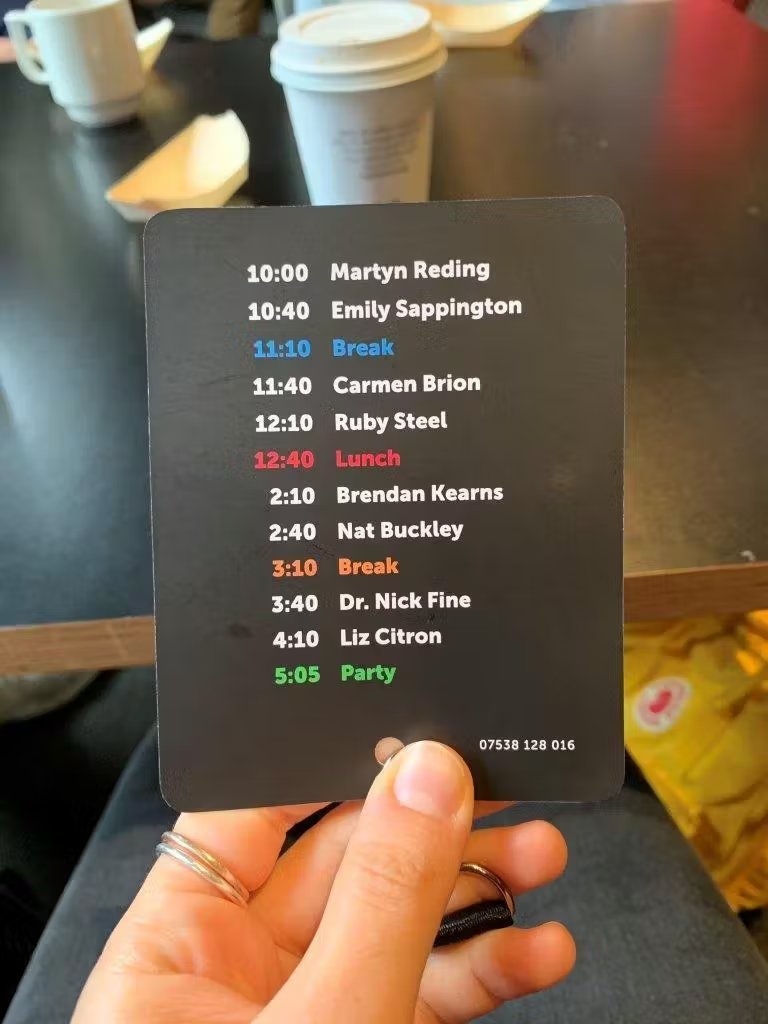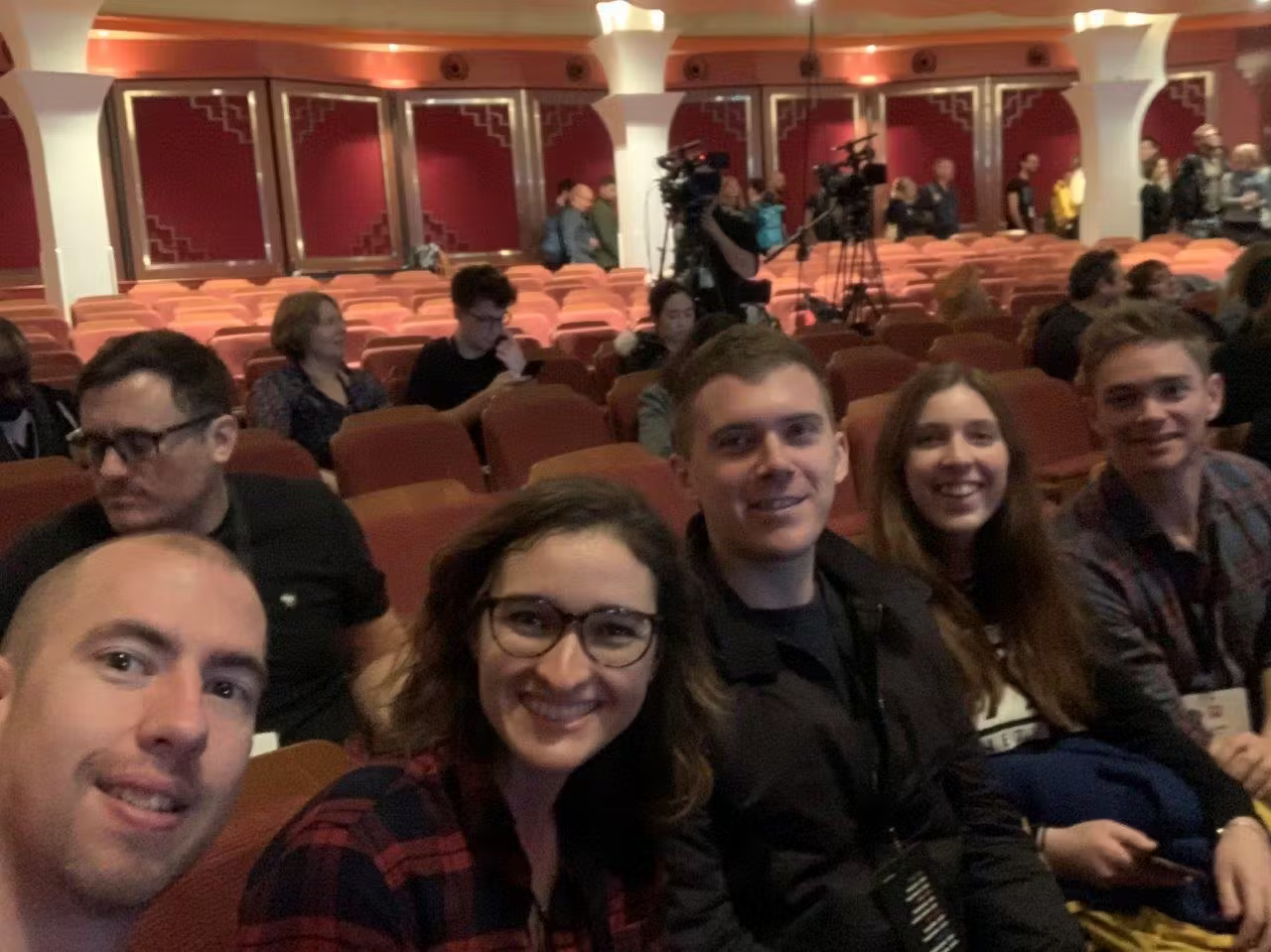5 things we learned at UX Brighton 2019

On a drizzly Friday morning, five members of Aiimi’s creative team set off to UX Brighton, a celebrated one-day UX conference held annually for the past nine years in Brighton.
That evening, we all left with heads full of new strategies for our work, fresh perspectives for our existing processes and the slightly glazed looks of people who have had an incredible amount of information thrown at them very quickly.
Given our varying job roles, we all took something different home from UX Brighton. Here, we’ve brought our unique perspectives together to highlight some of the content that spoke to us the most and that we plan on bringing back into our work. We hope it might just help you out and remind you why you love UX or inspire you to attend a similar event yourself!

As designers, we are not alone
Josh Stanley, Visual Designer
It’s not very often I find myself at these events, but when I do, I always leave with a similar thought. I wouldn’t say it’s one of awe and amazement at the exceptional talks and interesting characters (even though UX Brighton’s offerings were both exceptional and interesting!), but more a refreshing sense of community, cushioned by a blanket of industry professionalism, honesty and openness.
As my colleagues will tell you, this year’s UX Brighton hosted many valuable and relevant insights to the work and processes we've adopted at here at Aiimi. But more than anything, I’ve noticed how the daily issues and barriers we tend to face in the office seem to apply to most designers and UXers. A lot of these challenges were reiterated and supported in many of the day’s talks.
I especially loved Nat Buckley’s talk, ‘Good design is a team effort’. Being part of the fast-growing Aiimi Labs product team, I understand the need and importance to share, be transparent and learn from teammates.
The more we know as a team, and as a unit, the better our experiences, processes and ultimately our product, will become.
Events like UX Brighton not only provide an invaluable platform of insight and knowledge, but they’ve become a thriving environment full of shared experiences and empathy, honouring the true sense of word ‘community’. Whilst I wish I could have stayed longer and taken advantage of the pre- and post-event networking opportunities, I still left with a massive sense of pride in our profession.
If there’s one thing I can suggest to you it’s this: go out and explore your industry–see how far the rabbit hole goes. Attend events, welcome those just starting in UX and stand at the feet of design titans. I promise you’ll uncover—and more importantly be welcomed into—a community larger and more influential than you ever thought possible!
Design history repeats itself
Matt Lodge, UX/UI Designer
I must admit, I’m beginning to feel like an old dog at this kind of event. I’ve been in the creative industry now for what feels like a long time (I’m still young dagnabbit!) so teaching me new tricks is going to be next to impossible, if a little frustrating. That’s why I found the opening talk at UX Brighton, from Martyn Reding, quite reassuring as he looked back on the history of design roles and connected the dots to today’s equivalents.
Popular trends like design systems and pattern libraries have always reminded me of the brand guidelines I’d have to familiarise myself with in past roles within international organisations. DesignOps (a term so new I’d never come across it before – this old dog is learning!) is simply the same role as the studio managers whom I’ve been a nuisance to in years gone by, and the role of a UX designer and researcher has its foundations in the focus testing from the heyday of advertising.
As someone whose role involves looking forward to new ideas and user experience problems, this particular talk reminded me to take a step back and look to the past for inspiration. My future focus will now be (ironically) to spend a little more time in the past, reaffirming my ideas of what’s come before to help me in designing for the now and after.
The future of design is now
Jamie Leeson, Senior UI Designer
My biggest takeaway from this year’s event comes as a stark contrast to Matt’s comments around looking to the past for inspiration. Following a great talk from Ben Sauer on the principles of voice design, my biggest revelation from the event is that the ‘future’ of design (or at least my view of what ‘future design’ is) isn't actually in the future; it’s here now.
Chatbots, virtual assistants, and AI all sound like they’re cutting-edge technologies on the horizon, but to me as a UI designer, I’ve typically seen technologies like Siri and Alexa as novel consumer ways for setting reminders and Googling how long it takes to boil an egg. However, the reality is that they’re super powerful technologies for designers to leverage when building intuitive product solutions.
As Ben mentioned during his keynote, the design industry is quickly moving towards a voice-first model. As designers, we should be looking outside of our normal buttons, forms, and click-click-click model of UX/UI design to service this increasing demand for hands-off user-experience.
From the very start, Aiimi has been ahead of the curve, placing these ‘future’ technologies at our core–and they’re already paying huge dividends for our customers. Our flagship product, InsightMaker, uses the fundamentals of these same technologies to surface information for our users quicker than ever before and with amazing accuracy. Going forward, we know that voice will play a major role in this.
As designers, we should be looking outside of our normal buttons, forms, and click-click-click model of UX/UI design to service this increasing demand for hands-off user-experience.
Although there’s plenty of change, learning and development to get to grips with ahead of us, now is an exciting time for Aiimi and the design industry. I can’t wait to see where it leads to!

Consideration is key
Ella Simpson, Visual Designer
UX Brighton 2019 was my first experience at a design and UX event. Since I left on Friday evening after a great day, I’ve been going through all the talks to think about what I took away with me. All of the speakers were interesting and each refreshed different aspects of design in my mind. I have also been reflecting upon how to apply these to my own work here at Aiimi. At the end of the day, there’s no point going to an event if you’re not going to learn and utilise newly found knowledge!
One of the most relevant takeaways for me was the actual presentations themselves. I frequently design presentations for the Aiimi Sales & Marketing Team, but I am never the one who actually stands up to present them. In a way, attending this event was just the user research I needed! What works? Clean, minimalistic, bold designs that are easy to follow and remember.
That classic line that we all know and love comes into play here: Keep It Simple Stupid (KISS).
But, my biggest takeaway came when I considered all of the talks holistically. I realised that, for me, it was not really about looking at one talk alone, but how each of the speakers’ ideas all work together. Circling back through all the talks, something struck me – the big aha moment! – they all incorporated a message about consideration. Liz Citron’s talk reminded me that we need to be considerate to others and ourselves, Martyn Reding’s talk helped me see why we need to consider what came before us and the foundations of good design, Dr. Nick Fine’s talk emphasised the need to consider science in design, Nat Buckley talked about considering feedback from others, Ben Sauer touched on why we must consider designing for other users – and I could go on!
In design, there’s a lot more than just ‘making it look cool’. Taking a moment to think of all the necessary considerations within a project is a necessary step to producing an awesome piece of pixel-y wonder! One example which struck me was a video of a woman having to pronounce a name again and again until the digital assistant could understand what she was saying (it’s funnier if you watch it!). But it got me thinking about all the other applications of design as well – consider the person with poor sight; contrast and size of text is even more important. Consider the person who is colour blind; colour choice is integral. Consider the person with no sight; a video with sound allows them to now access the message. Consider the person with Parkinson’s disease; make that button big and easy to click with low accuracy! Know your user and design for them.
Taking a moment to think of all the necessary considerations within a project is a necessary step to producing an awesome piece of pixel-y wonder!
I’ll be trying my best to remember that whether I’m doing a piece of work, helping someone else, or working in a team, it always pays to be considerate.
Designing for trust
Shaina Koval, UI Designer & Developer
I, along with many others in product development, have fallen into a trap. New features are sexy, and it can be all too easy to ignore what makes a product trustworthy in favour of what makes it exciting. Emily Sappington’s talk, ‘Designing for AI’, has reminded me of the importance of looking away from the seductive glitz of new features. Instead, we must spend quality time building users’ trust and designing for the routes which users must take when the primary user journey fails them.
Day-to-day, I work on Aiimi Labs’ InsightMaker app where we are constantly embarking on new features, iterating on old ones, and dreaming of what comes next. One of the big themes of our future product strategy is about making the product more intelligent and proactive for users, rather than passive and reactive. Emily spoke about taking inspiration for AI for voice from human intelligence. The questions and concepts she posed as she went through this process are applicable to InsightMaker, despite it being a UI-driven web application and not a voice-controlled AI. Before aiming for intelligence in a product, she suggests we ask:
1. Does it respond to me? Looking at InsightMaker through this lens, I ask myself what we could be doing better to give users feedback to their actions. For a UI, this includes visual indicators like hover, focus, active and loading states as well quick response times—if a response takes too long, it’s almost like it didn’t happen at all. This also leads into accessibility, something we consider in designs and development but something we haven’t put as a priority in our testing. A product needs to respond to everyone, not just those with the most common visual and motor skills.
A product needs to respond to everyone, not just those with the most common visual and motor skills.
2. Is it competent? In our app, does user input correspond with the actions that a user expects to happen? Are users getting the results they want? There is a wealth of user testing we could be doing here on the functionality we already have and perhaps even more we could do to provide users with a fall-back solution when things fail. As Emily noted, if we can’t prove competence, users might not come back, so this is key before we even attempt to accomplish intelligence.
As we’re considering these questions, we also need to use our designs to set expectations—a concept Emily’s talk hammered home. Over-promising can lead to disappointment, which loses trust. When a user searches in InsightMaker for GDPR data, for example, do we clearly indicate what they can hope to find? How are search queries built and which words from a search term are used or ignored? Are we up front with the actions they’ll be able to take? In some areas, I think we have set our expectations, but you know what they say about the word ‘assume’ (and if you don’t, that proves my point about assumptions!). The only thing to do now is take out my metaphorical trust-focussed magnifying glass and get to work taking this methodology back to InsightMaker.
If you’re interested in finding out more about the speakers and topics at this year’s UX Brighton event or attending in 2020, take a look at their website.
Stay in the know with updates, articles, and events from Aiimi.
Discover more from Aiimi - we’ll keep you updated with our latest thought leadership, product news, and research reports, direct to your inbox.
You may unsubscribe from these communications at any time. For information about our commitment to protecting your information, please review our Privacy Policy.



